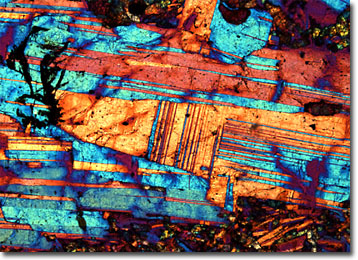Polarized Light Microscopy Digital Image Gallery
Olivine Pyroxene Andesite
Andesite is a type of finely crystalline rock of volcanic origin that typically consists of andesine or another plagioclase feldspar and one or more ferromagnesian minerals, such as pyroxene and olivine. This type of rock, which is common in the Andes Mountains from whence it gains its name, typically occurs in porphyries, large crystals of the feldspar or dark minerals it contains jutting out of a fine-grained matrix.

Comprising an important group of rock-forming minerals, olivines are common components of magnesium-rich, silica-poor igneous rocks. Moreover, olivines are generally believed to be among the most profuse components of the upper mantle of the Earth and have also been found in many meteorites. The name of the mineral group refers to the characteristic green coloring of its constituents. Perhaps the best-known type of olivine is peridot, the birthstone of the month of August.
Similar to olivine, pyroxene does not refer to a single mineral, but rather to a diverse group of silicate minerals. Members of this group exhibit variable composition and color, appearing in hues of white, yellow, green, brown, and black. Found in almost all volcanic rocks, as well as many metamorphic ones, René-Just Haüy coined the collective name of these minerals from the Greek words for “fire” and “stranger,” which is indicative of his assumption that these crystals were somehow accidentally introduced into the lava samples he was studying. Extremely widespread, pyroxenes also occur in many samples of lunar rocks.
